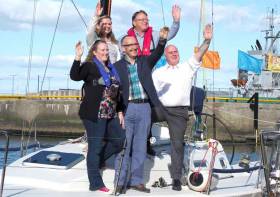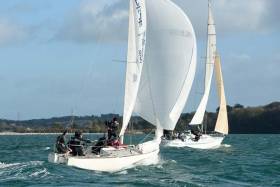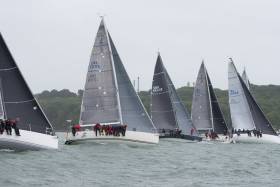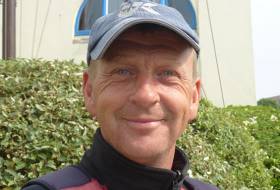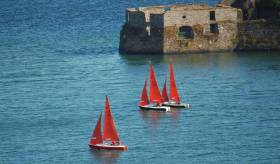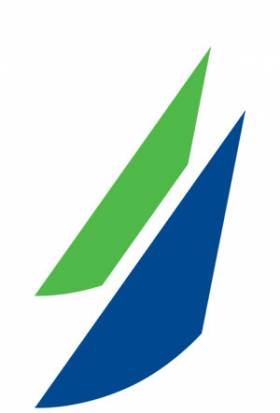Displaying items by tag: ICRA
Galway Way Bay Sailing Club Launch ICRA & WIORA 2018
This week Galway Bay Sailing Club (GBSC) members and friends gathered at Dock 1 Seafood Bar and restaurant in Galway Harbour for the official launch of the ICRA/WIORA 2018 which will be held in Galway Harbour from August 15th – 18th.
On a gloriously sunny Summer solstice evening the event chairman, Event organiser Martin Breen, kicked off proceedings by confirming how important it is for GBSC to host a national regatta in the Galway Docks.
Martin mentioned that GBSC has had a very sombre beginning to the season with the loss of longtime members Henry Lupton and David Fitzgerald. Even though of different generations, they were like-minded in their promotion of sailing and their exploits have been well documented on ‘Afloat’ie. It was their peers who wrote the constitution of GBSC which includes the club goal of ‘promoting the sport of Sailing on Galway Bay’ and it is within this goal that we sought the hosting of the 2018 ICRA National Championships.
"Please judge us in GBSC on how we contributed to promoting the sport of sailing on Galway Bay"
GBSC are really looking forward to providing the best of Galway hospitality ashore and the best of race management afloat, as the National Championships in any sport deserves.
Even though entries received to date are already in excess of entries to recent National Championships, GBSC says they do not consider this to be a benchmark of the success of the event. "Rather, after the Championships and when we begin to reflect on this season past about the time of the Autumn equinox, please judge us in GBSC on how we contributed to promoting the sport of sailing on Galway Bay".
Regatta Chairman Martin Breen reports strong interest for August's ICRA/WIORA 2018 event from all over Ireland and further afield.
The ICRA Vice-Commodore (Richard Colwell) and Commodore (Simon McGibney) are confirmed entrants with Breen confirming new entrants 'on a daily basis'. See provisional entry list here
The end of May is the end of the early bird period discount period, leaving sailors only a few days left to avail of great discounts!
As previously reported by Afloat.ie, the ICRA National Championship and WIORA from Aug 15th-18th are being held in association with Port of Galway under the guidance of Harbourmaster Capt Brian Sheridan. Capt. Sheridan has organised for there to be free berthage and craneage for the event so everyone can be catered for.
The end of May is the end of the early bird period discount period, leaving sailors only a few days left to avail of great discounts!
According to organisers, you will be able to leave your boat in the comfort of Galway Docks after racing and take the short walk into the bright lights of Galway City.
If you are sailing to Galway prior to the event you will also be accommodated. That way you can arrive in Galway for the regatta safe in the knowledge that your boat is there waiting for you.
Of course, a critical element of taking part in the event is securing accommodation and the team in Galway have their very own Accommodation officer, Aoife Macken, who has years of experience in the hospitality industry in Galway. She has put together a comprehensive list of accommodation options to suit all budgets which are available here
This includes 10 rooms in The Victoria Hotel right next to the docks so don’t delay as these rooms won’t be around for long! Aoife's contact details can also be found on this page should you have any questions. Galway is a busy place but there are plenty of beds for everyone.
As the central hub of the Wild Atlantic Way Galway and its environs has so much to offer that a good time is pretty much guaranteed while you’re here in mid-August.
Early bird entry ends on May 31st.
IRC Certs Ahead of Last Year for Irish Cruiser Racer Fleets?
There's good news for Irish cruiser–racers after a graph of International Rating Certificates (IRC) published by Irish Sailing administrators reveals a lift in certs issued so far this season.
It's an indication that more boats will be racing in a season that promises so much with June's inaugural Wave Regatta at Howth and the Round Ireland in Wicklow, July's Cork Week, and August's ICRA National Championships in Galway to name but a few.
The lift over 2017 numbers comes after several years of falling numbers and as such it will be cautiously welcomed by the recently recast Irish Cruiser Racing Body (ICRA) that is charged with increasing participation in cruiser–racer fleets.
All IRC certificates expire on 31st December of the year they are issued.
There are other variables that could have influenced the increase to April, one of which being 2018's early Easter which is the traditional IRC renewal date for the Summer season.
Against that, most sailors will agree that the 2018 season has been delayed by a fortnight or more due to bad weather in March and early April.
Harry Hermon of Irish Sailing says it will be more accurate to review the graph after quarter two, sometime in June, but for now the news looks positive for Irish cruiser–racing.
Exact numbers are hard to pin down but ECHO handicap cert stats offer another good indicator of the overall position, as all IRC holders also have an ECHO Cert. The latest position, from Irish Sailing files is below:
|
Racing (Jan-April) |
2014-Apr |
2014 Tot |
2015 - Apr |
2015 Tot |
2016-Apr |
2016 Tot |
2017-Apr |
2017 Tot |
2018-Apr |
|
ECHO certs issued |
294 |
499 |
209 |
489 |
270 |
455 |
277 |
497 |
280 |
|
IRC Revalidation |
200 |
281 |
208 |
291 |
204 |
||||
|
IRC New |
11 |
26 |
4 |
31 |
2 |
||||
|
IRC Amendment |
7 |
47 |
5 |
44 |
3 |
||||
|
IRC Trial |
5 |
20 |
5 |
36 |
11 |
||||
|
IRC Short Handed |
1 |
2 |
0 |
2 |
0 |
||||
|
IRC Copy |
7 |
11 |
5 |
14 |
16 |
||||
|
IRC Re-Registration |
0 |
89 |
0 |
1 |
The IRC rule is admimistered by London's Royal Ocean Racing Club. The RORC has been a leader in yacht handicap systems and in co-operation with the French offshore racing club, UNCL, created IRC - the principal yacht measurement system for the rating of racing yachts worldwide.
Hiking on the Rail – Human Ballast in Cruiser Racing
There has been controversy and disagreement in cruiser racing about crews ‘hiking out’ through lifelines on deck to get more upper body weight extended to help boat balance and performance … Rule changes have now come to “sitting on the rail” – an essential part of cruiser racing - though not always a pleasant or desired one, particularly in rough upwind conditions.
Extending the body as far out as possible, between lifelines, has become more obvious, even though that has been frowned upon by those who claim that the racing rules allow only for sitting on deck with the body fully inside the lifeline rails – apart from the legs of course, on the outside.
Now the IRC racing authorities have bowed to the inevitability of recognising reality and modified the rule on yacht ‘Crew Positions’ - This doesn’t seem to have got a lot of attention yet, but the racing season is only getting underway
“It is not unusual for crew sitting on the rail to be supported only at their upper legs when hiking facing outboard”
“The term ‘sitting on the deck’ is difficult to define,” the IRC Technical Committee has acknowledged…..
“It is not unusual for crew sitting on the rail to be supported only at their upper legs when hiking facing outboard,” it said in announcing the rule change.
 Sitting on the rail
Sitting on the rail
To avoid unnecessary and difficult protests, the IRC says it has decided on “a simple and effective solution” … removing rule requirements but keeping the original intention so - When there are two lifelines, competitors facing outboard with their waists inside the lower lifeline may have the upper part of their bodies outside the upper lifeline ….
Lifelines shall be taut “ which is a proper safety requirement anyway, though not always observed as I have seen…. So the IRC change is just bringing reality to racing….
It would be good to see another change in the process of “sitting on the rail…” to where quite a few newcomers to the sport have told me over the seasons that they were sent when they asked to join a crew to get into sailing.
I’ve been told by quite a few that they were never given any further involvement with the boats they were crewing on, never learned much about sailing, so they left the sport…. Others seemed satisfied enough to be “human ballast”….
I’m not sure that does anything much for the popularity of our sport…..
Podcast below
The Royal Cork Yacht Club at Crosshaven in Cork Harbour has decided on a change in the format of racing for the coming season which will reduce the number of starts and re-define the sailing classes.
In cruiser racing out of the club just two classes will sail under Spinnakers. This change met with general approval at a meeting of racing boat Skippers in the RCYC where the new handicapping arrangements were outlined by Mel Collins, Keelboat Committee Sailing Secretary. They will reduce Class bands 1, 2 and 3 to Spinnaker 1and Spinnaker 2.
Whitesail will continue, possibly with two classes, depending upon boat numbers.
"The changes are radical, as Skippers commented, but necessary it was generally felt, to bring more competitive interest back to racing"
IRC handicapping is controlled by the RORC, but ECHO handicapping will be administered by the RCYC Committee, with monthly changes. That could cause some controversy. Manual adjusting of handicaps of boats did so prior to the introduction of computer-based racing programmes which administered handicapping changes. That was pointed out at the meeting. However, the changes were approved, so it’s largely a ‘wait-and-see what happens’ attitude.
Handicapping changes have, in recent years, been automatically made by the computer-operated racing system after each race. Computer assessment will be available to the Committee, but it is a potential area of difficulty, as experienced Skippers pointed out.
However, as the numbers in cruiser racing have gradually moved upwards, this change and basically, it seems, amalgamate Class1 and the top of Class 2, with other former Class 2 boats mingling with Class 3.
More work will be done on the allocation of handicaps prior to the seasonal start and when boat owners submit their handicaps.
Friday night white sailing at the club will continue under the HIS in-house system.
There is a provision in the new arrangements to prevent ‘sandbagging’ – the first time I saw this publicly and clearly identified in pre-racing arrangements, to prevent those who might try to ‘massage’ their handicaps by slowing boat performance to gain advantage for specific events!
Podcast below:
ICRA EGM Adopts 'Interim' Constitution & Appoints New Executive
Last night's ICRA egm has removed a lot of uncertainty for the future direction of the cruiser racer body that was formally recast under new officers and an 'interim' constitution at its Portlaoise pow wow.
After months of turbulence for the voluntary organisation, the make-up of its executive and the location of its national championships was confirmed to the 26 members who attended the EGM.
A new 'interim' constitution was also adopted until a more comprehensive document can be tabled at the Autumn conference and agm.
The meeting also confirmed it's 'full steam ahead' for the National Championships to be hosted by Galway Bay Sailing Club in August, the first time the event will be sailed in Galway Bay.
ICRA Executive nominations were received and a new executive appointed under Commodore Simon McGibney and Vice Commodore Richard Colwell. The Hon Secretary is Cxema Pico, and the Hon. Treasurer is John Leech.
The 2018 ICRA executive is:
Simon McGibney (Commodore)
Richard Colwell (Vice Commodore)
Cxema Pico (Hon Secretary)
Colin Morehead (Training)
John Leech Hon (Hon Treasurer)
Rob McConnell / Cxema Pico (Communications)
Richard Morris (Strategic Planning)
Peter Ryan (ISORA)
Mark Mills (Techinical)
Kieran O'Connell
Finbarr O'Regan
Rory Carberry (Irish Sailing Board Member)
ICRA EGM Tonight to Vote on New Executive & Interim Constitution
ICRA Commodore Simon McGibney has issued the agenda for tonight's EGM to be held at 7.30pm Maldron Hotel in Portlaoise.
The meeting will vote on new candidates for the ICRA executive and will also vote on a new constitution.
The final reminder – issued via Facebook last night – comes as the cruiser racer body prepares to adopt an 'interim' constitution after a turbulent time for the organisation.
McGibney says he is looking forward to 'a productive session for Cruiser Racing in Ireland'.
ICRA EGM Agenda
- Apologies
- Presentation of Interim Constitution
- Vote on the introduction of the Interim Constitution
- Presentation of Candidates to Executive
- Vote on Executive
- Any other Business
A further ICRA message on social media says: "In order to ensure that ICRA continues to receive the strong support of members, it was agreed to review the constitution, reinforce good governance, transparency and accountability".
The message continues: "It was agreed that an EGM would be held as quickly as possible, with all members invited to attend. In order to do this before the sailing season begins in earnest, and due to the cluttered rugby and sailing calendar during March, the date of the meeting was agreed as Wednesday the 21st March 2018 in the Maldron Hotel, Portlaoise at 7.30pm".
The Cost of a Sailing Cruiser – ICRA – & 50 Years of Squibs
It’s still cold enough in boatyards to require determination to take off the covers, slide back the hatch and go below to start the annual preparation work. There are some more determined than others to have their boats ready to get the maximum out of the season but, having listened to a work colleague who presented me with a mathematical disassembly of the costs of owning a boat – the balance sheet he compiled in that cold analysis was on the financial red side - my emotional attachment to my boat and the sport of sailing didn’t impress him.
I hear, though, from other owners, telling me that they have also compared cost and usage, but I’m trying to cast aside such disturbing issues as news comes that the cruiser racing season will start on the South Coast on post–St.Patrick’s Day Bank Holiday next Monday – at Kinsale Yacht Club where the March League will provide an All-In introduction to the year for Spinnaker and White Sail Boats.
That notice came as I got a reminder that ICRA members will gather at the Maldron Hotel in Portlaoise on Wednesday night of next week, March 21, at 7.30 p.m. for the extraordinary general meeting which follows on the travails of the organisation in recent months,
The Interim Constitution, which will be voted on, mainly has changes to the management structure, as it appears from its publication on the Irish Cruiser Racing Association’s website, which says that the objective is to “allow the membership the greatest freedom to elect an Executive Committee while ensuring that the views of each region are represented.”
There is emphasis on ensuring a spread of representation from what is described as “the main cruiser fleets and areas…” It provides for the election of a Commodore and Vice Commodore, an Executive Officer and or a National Handicap Officer, a General Council and an Executive Committee, the latter to manage the business of the Association and with power to co-opt members.
The immediate task for the new Executive will be to carry out a review of the objectives and governance of the Association to ensure that it remains relevant to the membership. A 5-year plan and Constitution will be brought back to the membership for adoption.
Squibs 50th Anniversary
From that onshore debate, back to Kinsale and that club’s fleet of Squibs which, from continuing the club’s commitment to disabled sailing, has also become a highly competitive able-bodied boat, to judge from the Frosbite Series where the boats dealt with a wind gusting to 22 knots on the final day last Sunday. Not alone did that make it tough for the sailors but for the Race Committee whose boat was hit not once but three times by racing Squibs - once when one boat was approaching the finishing line; another when starting and the third after finishing a race.
I’m told from Kinsale that plans are underway to mark the 50th anniversary of the Squib Class this August at Calves Week. The prototype Squib was built by boat designer Oliver Lee in 1967, as a successor to the Ajax 23 and the first GRP version was launched in 1968.
• Listen to the Podcast below
Changing Gears in Different Wind Conditions While Racing
Mark Mansfield, Racing Consultant for UK Sailmakers Ireland, previously wrote about tuning a fractionally rigged mast. In this latest article, in association with ICRA, the four time Olympian describes how to set up the mast and sails for best performance upwind in different wind conditions
BASICS
The first article dealt with getting your mast in a basic good position, centralised sideways, the correct basic rake, the correct shroud tension and finally the correct prebend. This should always be done in medium wind conditions in what we would call the 'base position', normally 11 to 15 knots. It is assumed that once this initial base wind tuning has been done, the sails, when set, fit the mast prebend properly.
By this, I mean when going upwind in say, 12 or 13 knots the mainsail looks to be in a good aerofoil shape (see photo below), with a little bit of backstay tightened. No overbending would be evident (wrinkles running from the mainsail clew to the middle of the mast). Likewise the mainsail in these conditions should not look too full.
It is important to get the mainsail right in these conditions as sometimes the main might just be cut too flat or be just too full and may need a small alteration to the luffround by your sailmaker. When you pull on a lot of backstay in these 12/13 knots conditions, if you still do not get overbend wrinkles, as stated above, the chances are that the main has too much luffround and needs a bit taken out.
On the other hand, if, in 12/13 knots of wind, you get overbend wrinkles immediately you put on a small amount of backstay, it is likely the mainsail is too flat in the luff and will need some luffround added by your sailmaker. These are not very difficult adjustments for a sailmaker and can really make a difference. It is possible to adjust the rigging a bit to help rectify these problems, but really it can often lead then to further issues. So, say your main is looking a bit deep and you ease the lower shrouds to allow the mast to bend forward more, then the mast, in addition to bending further fore and aft also bends sideways to leeward. This, then in slightly stronger winds closes the slot between the main and jib and can be slow.
It is very rare that a mainsail will look fantastic in light, medium and strong wind conditions. As a general rule you design a main, for Irish conditions, to be best in moderate winds and you then either live with it in the other conditions or you adjust the rig to try and get the rig to fit the sail in those light and heavy conditions.
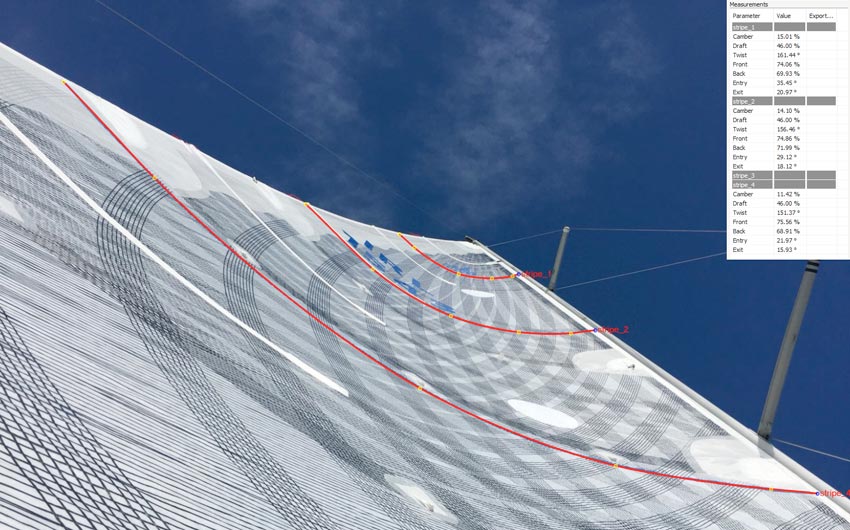
BASE WIND ADJUSTMENTS
All right, let's say the Main does now fit the Mast (either it was right or has been altered by your sailmaker). In these base (11 to 15 knots) winds you are going upwind nicely, with all your crew on the rail and hiking (hopefully hiking hard—really important). What should be evident is your headstay should be moderately tight, maybe a little bit of fall off, your mainsheet should be fairly tight with the top leech telltail streaming most of the time. Your backstay will be tightened a bit and as the wind ranges from say 11 to the 15 knot base range, you will be adjusting your backstay (tighter in the stronger range and less in the lower range). As you tighten backstay, the mainsheet needs to be pulled on more and because this pulls the mast back, it will open the jib leech, so normally the jib needs to be sheeted in more or maybe the jib lead moved forward. As the breeze increases, a telltail sign that you need to tighten backstay is if the helm gets heavy.
Conversely, if the breeze eases and the helm feels a bit dead, then easing the backstay will give you power. But remember, this then will likely require the mainsheet to be eased and the jib sheet eased. I will discuss the importance of the helm feel later.
One adjustment I have not mentioned yet is the main traveller. Up until weather helm becomes excessive, the traveller can be kept in the middle or even to weather. In lighter airs, you can keep the traveller well to weather, and even the boom can be above centerline. My rule of thumb in light air is to have the mainsail clew, (about a foot or two up the leech), in the centre. This may mean the boom is a bit above the centreline but most of the sail is not and that will give you more power and feel on the helm which is very important in light winds. In the higher end of this base (11-15knots) wind range, you may need to leave the traveller down below the centerline to ease weather helm. Try backstay on first though which will tighten the forestay and flatten the sail plan. If this still results in too much helm, then drop the traveller, but only 400 mm or so to leeward of centre. Dropping it too much just closes the slot between the main and jib and leads to a lot of mainsail backwinding which is slow. The reality is if you are overpowered to the level of dropping the traveller further, you really should be on a smaller or flatter Jib. Likely though, in these 11- 15 knot winds you will not be that overpowered.
Below this wind range (less than 10 knots) you are looking for power in order to get all the crew fully on the rail and hiking. Above the base wind range (over 15 knots), you are depowering the boat upwind by flattening and twisting the sails.
 The weight on the helm is extremely important. As a general rule, 5 or 6 degrees of weather helm is what you are looking for Photo: Afloat.ie
The weight on the helm is extremely important. As a general rule, 5 or 6 degrees of weather helm is what you are looking for Photo: Afloat.ie
HELM
The helm is the most important indicator of whether the boat is set up correctly or not. It will talk to you, if you listen. Most of my sailing career has been as a helm, Admiral's Cups in the 80’s, one designs in the 90’s (Olympics in Stars, 1720’s, Melges 24's, Mumm 30’s), Commodores Cup etc in the last 10 or 15 years. The weight on the helm is extremely important. As a general rule, 5 or 6 degrees of weather helm is what you are looking for. A bit of weather helm, though it adds drag, is good. The rudder, when it is angled 5 or 6 degrees will give the boat lift. It is not just the keel that gives lift, so does the rudder. If you have neutral helm, chances are you are not pointing that well, and if you have too much helm, chances are you are going slow. If you are wheel steered, put a mark on both sides of central to show what 6 degrees of helm represents. If a tiller, work out also what 6 degrees relates to.
The best mainsheet trimmers, you will find, were also helms. You will see them constantly looking at the helm while they are trimming the main to try and keep the helm in the correct position. If they were helms you will find that they understand what your problems are very early on and will try and address them quickly. It is also very important for a helm to communicate with the mainsheet trimmer what he/she is feeling from the helm.
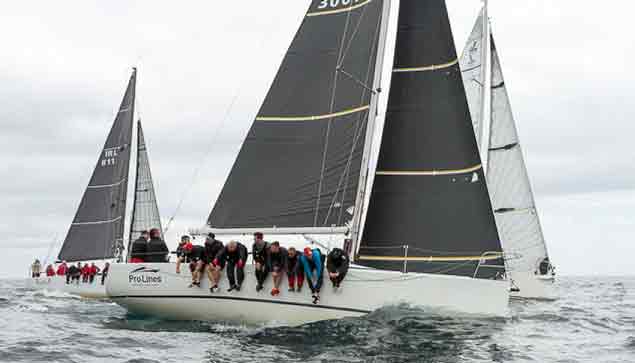 It is very rare that a mainsail can look fantastic in light, medium and strong wind conditions. As a general rule you design a main, for Irish conditions, to be best in moderate winds and you then either live with it in the other conditions or you adjust the rig to try and get the rig to fit the sail in those light and heavy conditions Photo: Bob Bateman
It is very rare that a mainsail can look fantastic in light, medium and strong wind conditions. As a general rule you design a main, for Irish conditions, to be best in moderate winds and you then either live with it in the other conditions or you adjust the rig to try and get the rig to fit the sail in those light and heavy conditions Photo: Bob Bateman
FORESTAY
Another indicator of whether the boat is set up correctly or not, in addition to the helm, is how the forestay looks. In lighter airs, you want the forestay to have some sag, as this will build power, which will add lift also. As the breeze increases, to say 10 knots or so, tightening the mainsheet will automatically tighten the forestay a little. While all this is happening the backstay will just stay snug. Don’t have the backstay flopping around as this will result in the forestay pumping forwards and backwards in the waves. Until the helm starts to get heavy, it is still good to have some forestay sag. If the forestay tension was set correct initially you will find that as the wind increases from light to medium, the amount of sag in the forestay should decrease just nicely as you initially take on extra mainsheet and then eventually start to take on backstay. As the breeze gets to 14 or 15 knots or so, you generally want the forestay pretty straight as you are now starting to depower a bit. If you are depowering, then a straight forestay means you can point higher.
RIG CHANGES OUTSIDE BASE
All of the above discussion is based on not changing the Standing Rigging (forestay and shrouds) in different wind conditions. For most racing boat owners they will be just happy to get a good base setting and will lock off the shrouds and forestays with rigging pins. In this situation they will be happy with maybe being a little underpowered in the lighter airs and will live with being a bit overpowered in the stronger winds.
However there are good gains to be made in adjusting the rig regularly. Perhaps only 25% or so of boats in Ireland that race at a good level will adjust their rigging for different wind conditions, but you will likely find that most of these will end up towards the top of the fleet.
I normally will have five rig settings:
- 0-7 kts—very light--all crew normally down to leeward—soften and ease rig a lot
- 8-11 kts-transitioning—few crew to weather early and then all – softer than base
- 12-15 kts – Base – (see above)
- 15-20 kts—Depowering a bit. Tighter than Base
- 20 kts and above—Full on powered up, very tight rig
In my next article, I will go through the options to getting to these lighter and heavier rig tensions and what each change of the rig will bring. I will show a chart we have done for a well known one design, the J109, showing what to do in each of these conditions and most importantly will explain, once the shrouds and forestay are adjusted, how to set the sails to maxamise these Rig changes. This chart, though aimed at the J109, will be similar for most cruiser racers.
I will also offer an intermediate option to adjusting all your shrouds and forestay that will be nearly as efficient and will be more easily reproduced. The problem with changing all your shrouds and forestay in each condition is that in very many cases you lose track of what setting you are on. Also, as happens a lot, often someone tightens a bottlescrew when they think the are loosening it which leads to S bends appearing in the mast. Fair Sailing – Mark Mansfield
 Article author Mark Mansfield Photo: Afloat.ie
Article author Mark Mansfield Photo: Afloat.ie
In addition to being a self employed sailing Consultant for UK Sailmakers Ireland, Mark Mansfield is a Professional Sailor. He has been competing for 35–years on the International stage including four Olympics in the Star Class, four Admirals Cups in the 80’s, Commodores Cups in the last ten years and numerous other One Design and big boat campaigns. He has a specialisation in rig tuning and has tuned many of the top racing yachts in Ireland. He also is a noted tactician and was tactician on boats which have won their class in the last 3 ICRA nationals, the last three Volvo Dun Laoghaire Regattas (incl overall boat in 2017), IRC Europeans winner, Cowes Week winner, Spi Ouest winner, Cork Week, Scottish Series, UK IRC winner etc. He is a two times Irish Sailor of the Year and a two times Irish Helmsmans Champion. He is available to sail with, coach, tune rigs or advise on rating improvements for any boat, whether they use UK sails or not. Contact Mark at [email protected] or mobile: 087 2506838
Other articles in the UK Sailmakers Ireland/ICRA 'How to...' Series:
Introducing The UK Sailmakers Ireland 'How To' Article Series
Sailmaking Tips & Tricks: Battens, Furling & Caring for Sails
Tuning a Fractional Mast & Rig
Extraordinary General Meeting of ICRA Called
An extraordinary general meeting (EGM) of the Irish Cruiser Racing Association has been called for Wednesday, March 21.
It will be held in the Maldron Hotel in Portlaoise at 7.30 p.m. and a new Executive Committee will be voted into position.
The meeting follows the controversy which has arisen within the Association. A new “interim constitution” is also be voted on by members at the meeting.
Nominations are open for any member to go forward for election to the Executive.
A list of the candidates is to be made available on the ICRA website three days before the Portlaoise meeting.
Current Commodore Simon McGibney has written to members of ICRA expressing the hope that the meeting will be a “productive session that enables ICRA to take relevant steps towards renewing its commitment to cruiser racing in Ireland.”
ICRA Statement on Feb 13 2018:
The ICRA Executive held an emergency meeting on Friday 9th February, in light of the discussions that were held in Limerick (20th January) on our long term plan. In order to ensure that ICRA continues to receive the strong support of members, it was agreed to review the constitution, reinforce good governance, transparency and accountability.
1- Notice of EGM
It was agreed that an EGM would be held as quickly as possible, with all members invited to attend. In order to do this before the sailing season begins in earnest, and due to the cluttered rugby and sailing calendar during March, the date of the meeting was agreed as Wednesday the 21st March 2018 in the Maldron Hotel, Portlaoise at 7.30pm. Members will be as defined in the interim constitution. At the EGM the new interim constitution would be voted on by members. The interim constitution will be available on the ICRA website within two weeks.
2- New ICRA Executive
In line with the new interim constitution a new executive will be voted in by members at the EGM. Any member who wishes to stand as a member of the executive is encouraged to put forward their candidacy by completing the form on the ICRA website and submitting it no later than 1 week before the meeting (Wednesday 14 March 2018 at 7.30pm.). Any member putting their candidacy forward needs to be proposed and seconded by members. The completed form signed by proposer and seconder, plus a copy of their 2017-2018 IRC or ECHO cert need to be brought to the EGM. The current committee will endeavour to make list of candidates that have put themselves forward made available on the website 3 days before the event.
I look forward to sharing a productive session that enables ICRA to take relevant steps towards renewing its commitment to Cruiser Racing in Ireland.
Simon McGibney
ICRA Commodore


























